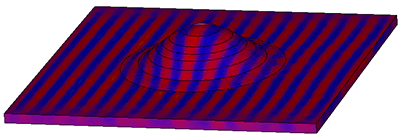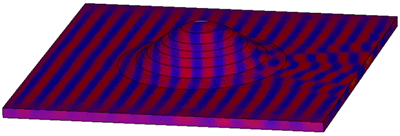The researchers coated a curved surface with a medium where the refractive index – a measure of how light passes through substances – varies depending on the position of the wave. Although the coating is only a fraction of a wavelength thick, it can make the curvature appear invisible to surface waves.
The coating can be used as a cloak because the space created underneath the bumpy surface can shelter an object that would ordinarily have caused the wave to be scattered.
Professor of Antennas and Electromagnetics and study lead Yang Hao, said: “The design is based upon transformation optics, a concept behind the idea of the invisibility cloak. While the cloak is yet to be demonstrated ‘perfect’ in the free space, we have proved that it is possible for surface waves.”
The underlying theory developed in this study has had a wide impact on the antennas and aerospace industry, which UK has strong presence internationally.
“With the demands of telecommunications systems in airborne and ground-based vehicles growing year by year, it is necessary to create antennas with ever increasing efficiency, yet keeping the weight and volume as low as possible,” said co-author Dr Rhiannon Mitchell-Thomas from Queen Mary’s School of Electronic Engineering and Computer Science
“When electromagnetic waves encounter a bump in the surface, this alters their characteristics and decreases the efficiency of the antenna. Using this new technique, a bespoke surface wave antenna can be designed to fit the precise shape of the platform.”
The figure on top shows the cloak in action, and the figure on the bottom shows what happens when the cloak design is not used. Plane electromagnetic surface waves are incident from the left and are scattered by the bump, but the cloak is able to remove the scattering, and the waves are the same shape after propagating across the bump. .
Co-author Dr Oscar Quevedo-Teruel also from Queen Mary’s School of Electronic Engineering and Computer Science added: “This type of integrated antenna system can be applied for any frequency band from microwave to optics, leading to ultra-fast wireless communication over the surface in the near future.”
The research is funded by a prestigious EPSRC programme grant – QUEST (The quest for ultimate electromagnetics using spatial transformations) and is published today (Wednesday 20 November) in the journal Physical Review Letters.
Professor Hao added: “I am very thankful to EPSRC for funding our research. The programme grant has enabled us to work closely with Dr Simon Horsley, at the University of Exeter.
“This substantial investment has also brought fresh ideas and enthusiasm from young researchers including our PhD student, Timothy Michael McManus.”
Want to know more? Watch this video to hear about metamaterials - artificial materials that have unusual properties not found in nature - could have an impact in all walks of life from invisible cloaks to improving antenna design.





